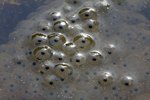Things You'll Need
Large Aquarium
Bubbler
Thermometer
Litmus paper
Vinegar
Baking soda
Small aquariums
Gravel
Rocks
Tiles
Minnow net
Meat
Vegetables
Shrimp
Insects
Fish food
Feeder fish
Warnings
Stay clear of the crayfish's claws to avoid getting pinched.
Tips
Don't keep aquatic plants in the tank; the crayfish will eat them.
Freshwater crayfish are often called crawdads or crawfish. They are raised in homes as exotic pets, aquarium cleaners, fishing bait or as food for other reptiles, such as turtles. Crayfish look like miniature versions of their saltwater cousins, the lobsters. Around 150 crayfish species inhabit the rivers, streams and freshwater ponds of North America. Most species are red, brown or tan. Some types are blue or green. The crustaceans are raised at home in aquariums.
Prepare an aquarium ahead of time for the freshwater crayfish. Use a 1-by-2-foot-long tank for each pair. Put a layer of gravel on the bottom. Arrange rocks, tiles, flowerpots or decorative objects to create nooks and crannies for hiding places. Aerate the water with a fish-tank bubbler, as crayfish breathe through gills. Keep the pH at neutral or slightly alkaline, in the range of 7.0 to 8.5. Test the pH with litmus paper. Add baking soda or vinegar to adjust the pH. Use a thermometer and fish tank water heater with a thermostat to maintain a water temperature of 65 to 80 degrees Fahrenheit for optimum growth.
Buy freshwater crayfish at the local pet store, or catch your own. Look for crayfish along the shores of ponds and in the moving water of streams and creeks. Wade into the water and conduct your search upstream, with the stirred-up silt flowing behind you. Overturn rocks and large underwater branches to find crayfish during the day. Catch them in a minnow net, as they rapidly swim backwards when startled.
Feed the crayfish almost anything; they are omnivorous. Give them any kind of meat, dead or alive; they're both hunters and scavengers. Offer shrimp, fish food, insects or table scraps to determine their preferences. Provide guppies, minnows or goldfish feeder fish to molting crayfish. Nourish adult crayfish mainly with vegetables, such as peas, carrots and bits of lettuce or cabbage. Feed them daily, as much as they will consume in a single sitting.
Take steps to lessen the consequences of the crayfish's territorialism. Keep them apart by providing hiding places on opposite ends of the tank and feeding them in different tank locations. Keep them well-fed to avoid contact leading to fighting and cannibalism. Add a glass or plastic divider if necessary.
Breed your crayfish to keep a population going, as they only live for two or three years. Identify the male by its longer pincers and genital openings, called gonopods, located behind and under the last set of legs. Look for a wide tail and genital openings under the third set of legs from the rear to sex a female. Keep them together until you see eggs under the female's tail. Move the babies to smaller aquariums in groups of 20. Separate them when they start to eat each other.
References
Tips
- Don't keep aquatic plants in the tank; the crayfish will eat them.
Warnings
- Stay clear of the crayfish's claws to avoid getting pinched.
Photo Credits
-
Ablestock.com/AbleStock.com/Getty Images





